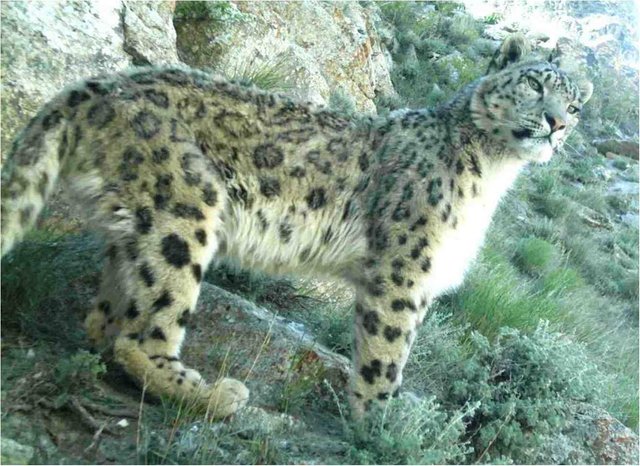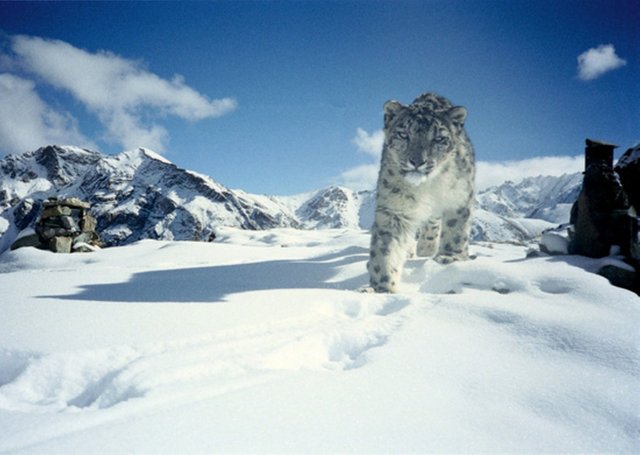The Snow leopard (Panthera uncia) is no longer classified as “Endangered” by the IUCN
The snow leopard (Panthera uncia) is a large feline that inhabits the mountain ranges of Central and South Asia, and lives in the alpine and subalpine zones high up in the mountains. It is mostly found at 3,000+ meters, but can be found in lower altitudes in the northern part of its habitat. Just like many of the other Panthera cats it is a pretty rare cat, and it was classified as Endangered until yesterday.

A snow leopard in Afghanistan. Image is Public Domain.
The official global Red List is made by the IUCN, and they have several categories to classify the degree of threat to the survival of the species. The most extreme is “critically endangered”, followed by “endangered”. As of yesterday the snow leopards were downgraded to be “vulnerable”. This means that their species has a higher expected probability of surviving for the next 100 years without human interventions, but it is still far from 100 % secure.
As of now we expect to have around 4,000 snow leopards left in the entire world, which is pretty few considering the fact that they inhabits such a huge area. Some reports gives us a bit higher number, such as 8,000 individuals, but the 4,000 one is the generally agreed upon number. According to UICN they would require it to be less than 2,500 for it to be "critically endangered".

Image is Public Domain.
Are we able to save the snow leopard?
There are lots of different conservation efforts in place to help the snow leopard survive, and these are the major reason why the snow leopard got downgraded from “endangered” to “vulnerable”. However, we really need these efforts to continue, because the species is likely to not be completely self-sustainable as of right now.
Conserving a species that uses a large area is incredible difficult. In the case of the snow leopard we need to conserve the species in countries such as China, Afghanistan, Mongolia, Kyrgyzstan, Pakistan, Nepal and more, and getting all the 11 different countries to agree on a conservation plan can be really challenging.
Luckily the snow leopard is somewhat easy to breed in captivity, so there are several breeding programs in place. In these facilities, grown snow leopards are mated and raise the offspring, which in then released into the wild at a suitable age. Some might argue that this not the best strategy for keeping a species alive, and I agree, but I don’t think the snow leopard would have anything close to the 4,000 individuals it currently has if it had not been for the breeding programs.
Thanks for reading
Thanks for reading my short post about the declassification of the snow leopard. I really hope this species is able to keep getting a higher population, and one day it might even be classified as “Least Concern”! If you want to read more, check out the official IUCN article about the snow leopard or check out panthera.org’s short interview with IUCN about why it got downgraded!
About the author
Hi, I’m @valth! I live in Norway with my wife, our baby, and our two dogs; one of which is seen wearing a bow tie in the profile picture!
I am very passionate about nature and biology, and have been studying ecology for a few years now. My passions are mostly within conservation biology, mycology (the studies of mushrooms), botany, animal behavior and general microbiology. I really enjoy both the theoretical aspect, as well as the more practical aspect of biology, and I spend about as much time in front of biology textbooks as I do spend on finding and identifying plant, mushroom and animal species in the forests.
Make sure to hit the big follow button above to go to my profile and follow me! This will make sure all of my posts end up right in your feed, and you can get your daily dose of biology news without any hassle :)

Although the path is still long for this species, this is a very good intermediate step. And it is nice to read that humans can also do good things, once in a while.
I had a chance to recently see those animals in an animal park in Belgium. They are really beautiful.
Yeah, it's a good beginning! We're still far away from saving the species, and as I wrote, we need to keep up the conservation and breeding programs if it's to survive long-term.
That must have been really great! I can imagine that they are very beautiful in real life ;)
Yes they are. I have the chance to have been able to visit that park. There are so many animals there (and an animal park is not a zoo: no cages, a lot of space for the animals, etc...)
Awesome info and photographs. Such a beautiful animal.
Thank you :)
i love pathera, i have one!
if you want to see., here is my pathera!
https://steemit.com/caturdaycollagecontest/@pepiflowers/caturdaycollagecontest-1-cricri
nice day for you!
i am upvoted and reply your post plz visit me
upvoted,reply,follow and resteem when you work in steemit thanks alot,
my id = https://steemit.com/@pranashroy
@valth got you a $7.9 @minnowbooster upgoat, nice! (Image: pixabay.com)
Want a boost? Click here to read more!
This post recieved an upvote from minnowpond. If you would like to recieve upvotes from minnowpond on all your posts, simply FOLLOW @minnowpond
This post recieved an upvote from minnowpond. If you would like to recieve upvotes from minnowpond on all your posts, simply FOLLOW @minnowpond
This post has received a 1.39 % upvote from @booster thanks to: @valth.
This post has received a 15.94 % upvote from @bellyrub thanks to: @valth.
@valth Incredibly pleasant completion of article! Beloved the photographs and outline..